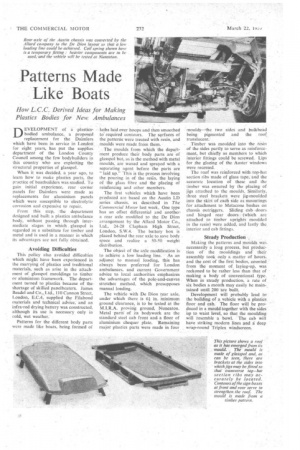Patterns Made Like Boats
Page 42

If you've noticed an error in this article please click here to report it so we can fix it.
How L.C.C. Derived Ideas for Making Plastics Bodies for New. Ambulances
DEVELOPMENT of a -plasticsbodied ambulance, a proposed replacement for the Daimlers which have been in service in London for eight years, has put the supplies department of the London County Council among the few bodybuilders in this country who are exploiting the structural properties of glasspol.
When it was decided, a year ago, to learn how to make plastics parts, the practice of boatbuilders was studied. To gain initial experience, rear corner panels for Daimlers were made as replacements for aluminium panels which were susceptible to electrolytic corrosion and expensive to repair.
From this step, the department designed and built a plastics ambulance body, without passing through intermediate stages in which glasspol is regarded as a substitute for timber and metal and is used in a manner in which its advantages are not fully obtained.
Avoiding Difficulties This policy also avoided difficulties which might have been experienced in the marrying of plastics and traditional materials, such as arise in the attachment of glasspol mouldings to timber or aluminium framework. The department turned to plastics because of theshortage of skilled panelbeaters. lames Readel and Co., Ltd., 110 Cannon Street, London, E.C.4, supplied the Filabond materials and technical advice, and an infra-red drying battery was constructed, although its use is necessary only in cold, wet weather.
Patterns for the different body parts were made like boats, being formed of • laths laid over hoops and then smoothed to required contours. The surfaces of the patterns were treated with resin, and moulds were made from them.
The moulds from which the department produce their body parts are of glasspol but, as is the method with metal moulds, are waxed and sprayed with a separating agent before the parts are "laid up." This is the process involving the pouring in of the resin, the laying of the glass fibre and the placing of reinforcing and other members.
The first vehicles which have been produced are based on the Austin LD series chassis, as described in The Commercial Motor last week. One type has an offset differential and another. a rear axle modified to the De Dion arrangement by the Allard Motor Co., Ltd., 24-28 Clapham High Street, London, S.W.4. The battery box is placed behind the rear axle to save body space and realize a 50-50 weight distribution,
The object of the axle modification is to achieve a low loading line. As an adjunct to manual loading, this has always been preferred for London ambulances, and current Government advice to local authorities emphasizes the advantages of the pole-and-canvas stretcher method, which presupposes manual loading.
The vehicle with De Diem rear axle, under which there is 6-1 in. minimum ground clearance, is to be tested at the lvf.I.R.A. proving ground, Nuneaton. Metal partsof its bodywork are the standard steel cab front and. a floor of aluminium chequer plate. Remaining major plastics parts were made in four
inatilds—the two sides and bulkhead being pigmented and the roof, translucent.
Timber was moulded into the resin of the sides partly to serve as reinforceMent, but chiefly as members to which interior fittings could be screwed. Lips for the glazing of the Auster windows were recessed.
The roof was reinforced with-top-hat section ribs made of glass tape, and the accurate location of these and the timber was ensured by the placing of jigs attached to the moulds. Similarly, three steel brackets were jig-moulded into the skirt of each side as mountings for attachment to Meta.cone bushes on chassis outriggers. Sliding cab doors and hinged rear doors (which are attached to timber uprights moulded in the resin) were added, and lastly the interior and cab fittings.
Steady Production ,
Making the patterns and moulds was necessarily a long process, but production of the mouldings and their assembly took only a matter of hours, and the cost of the first bodies, counted from the moment of laying-up, was reckoned to be rather less than that of making a body of conventional type. When in steady production, a rate of six bodies a month may easily be maintained until 200 are built.
Development will probably lead to the building of a vehicle with a plastics floor and cab. The floor will be produced in a mould together with the sides up to waist level, so that the mouldingwill `resemble a bowl. The cab will have striking modern lines and a' deep wrap-round Triplex windscreen.




























































































